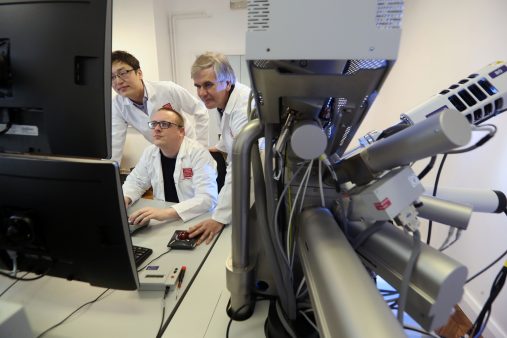A New Era for Electron Microscopy at Cardiff
13 July 2020
Cardiff University’s Translational Research Facility (TRF) – currently under construction on Cardiff Innovation Campus – is set to transform the research capability of two of the University’s leading centres: the Cardiff Catalysis Institute (CCI) and the Institute for Compound Semiconductors (ICS).
The impressive five-story structure, alongside the sbarc ǀ spark building and ICS Cleanroom, is a monument to the new era of transformative and translational research set to begin on Cardiff University’s Innovation Campus.
There is however, a relatively smaller building nestled within this complex that may only have been spotted by the keenest of observers. This building will house the new Cardiff Catalysis Institute Electron Microscopy Facility (CCI-EMF) along with the new Surface Science laboratories .
Electron Microscopy is a fundamental technique used by chemists (as well as in a broad range of other scientific disciplines) that allows study of materials at the nanoscale. This EM facility is made possible by bringing together £3.6m from European Regional Development Fund (ERDF) through the Welsh European Funding Office (WEFO) with £750K from the Wolfson Foundation, £3.7m from HEFCW and additional match funding from Cardiff University.
This funding and support will not only provide a world-class facility for CCI and the University, but also establish a much-needed base of advanced microscopy in Wales. One of the main aims is to not only increase research income and remain competitive, but also to provide local industries, institutes and businesses with cutting edge analytical facilities offering an ‘R&D innovation headquarters’ for research requiring these facilities, as well as creating a hub for EM expertise and skills development.
No facility comparable to the planned CCI-EMF exists in Wales. CCI researchers currently travel to Europe or the US to access advanced microscopy facilities suitable for carrying out this high-level catalyst research.
Excellent facilities such the electron Physical Sciences Imaging Centre (ePSIC) at Diamond and the mid-range EPSRC SuperSTEM facility at Daresbury are also accessible, but heavily oversubscribed, such is the demand for advanced analytical electron microscopy. The EMF is critical to the CCI’s future work, and to maintaining and improving its position as a world top-five catalysis research centre.
At the heart of the new facility will be a new aberration corrected scanning transmission electron microscope (AC-STEM). To drive future research discoveries around catalysis, the UK and international research community now needs to be able to study, observe and measure the structure and composition of these fascinating materials at the level of individual atoms (that is, at the nanoscale).
For decades, the limiting factor to achieving this resolution was the presence of spherical and chromatic aberrations brought about by imperfections in the electromagnetic lenses of the microscope. Today this can be overcome using specialised aberration corrector technology. The concept and design for the aberration corrector was proposed as early as the 1930’s, but it was only in the late 90’s that advances in computational power made it technologically possible and then commercially viable. This led to a quantum leap in the attainable resolution limits. What was once considered to be a very specialised technique is now more commonplace and is considered a vital analytical tool for catalyst characterisation.
State–of–the–art electron microscopes require incredibly stable environments. A floating keel-slab has been installed to minimise acoustic and mechanical vibrations. Similarly, both naturally occurring and mechanically induced electromagnetic fields that can perturb the electron beam will need to be attenuated using a Faraday cage. This means that the main microscope room will be built inside a double–layered metal box. Integrating this temperature-controlled box with the floating floor and other services is no mean feat – which is why this laboratory space has been so carefully designed to ensure maximum performance.
The Cardiff Catalysis Institute has collaborated with the excellent design and construction team at Bouygues UK working alongside consultants Global EMC and Colin Gordon Associates to come up with the best solution to a unique problem.
Even with the inevitable setbacks that come with such a complex engineering project and Covid-19 notwithstanding, construction work on the new facility continues at pace. The preliminary baseline measurements for background interference have been made, the designs to mitigate against these have been approved and already the main structure stands in place.
Although dwarfed by the main five story structure of the TRF, the simple exterior of the CCI-EMF belies a wealth of cutting edge design principles that will provide an ultra–quiet, ultra-stable platform for one of the most advanced microscopes for catalysis research in the world.
The creation of the AC-STEM facility will bring forth a new era in research capability for the CCI and Cardiff University as a whole.
The authors would like to thank the European Regional Development Fund (ERDF), the Welsh European Funding Office (WEFO), The Wolfson Foundation, The Higher Education Funding Council for Wales (HEFCW) and Cardiff University for their support.



